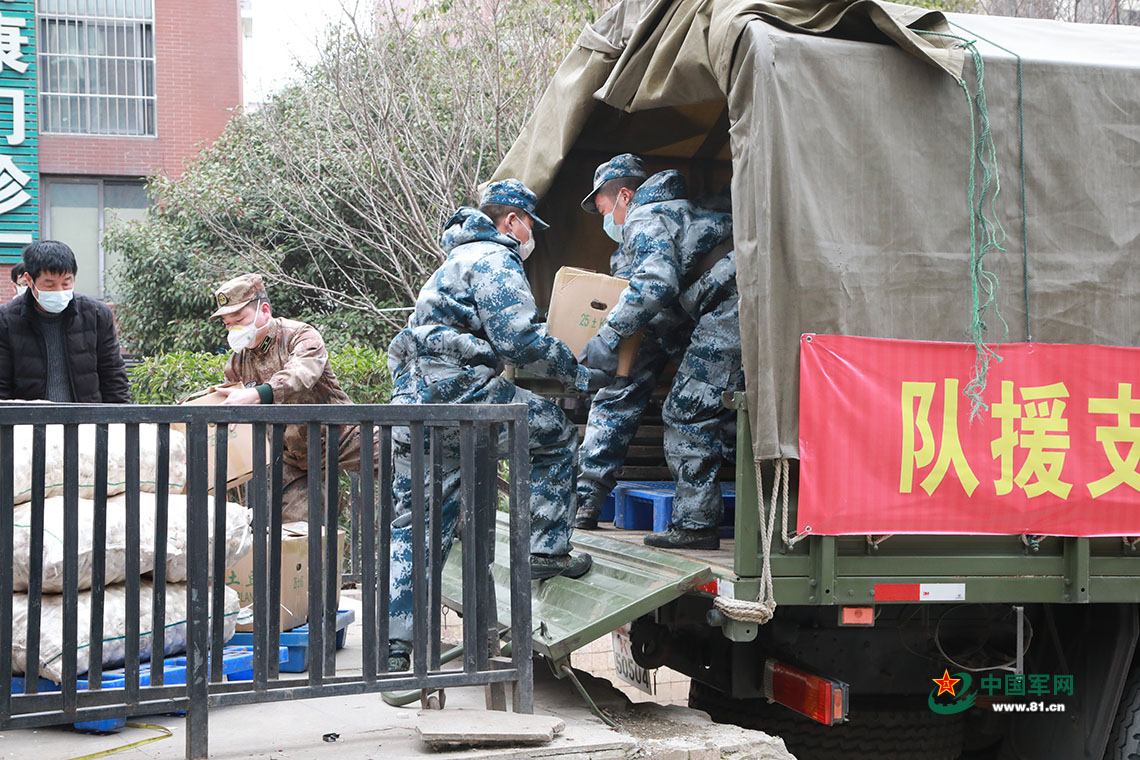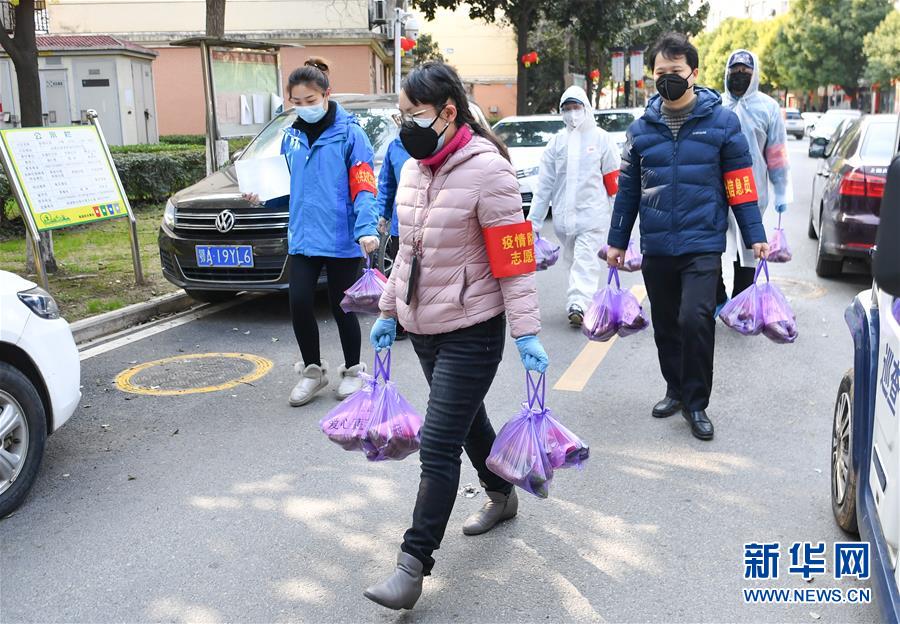

After locking down Wuhan, capital city of central China’s Hubei province, which used to be the epicenter of the novel coronavirus disease (COVID-19) outbreak, China mobilized nationwide resources and made all out efforts to guarantee a stable supply of living materials for the city’s residents. Many provinces around the country joined efforts to guarantee sufficient sources for these materials.
At the same time, various vehicles, including buses, military transport vehicles, cold chain logistics vehicles and postal vehicles were used to guarantee delivery coverage and efficiency in transporting living materials.
Staff members from major shops and supermarkets, community workers, volunteers, and Communist Party of China (CPC) cadres dispatched to grassroots levels helped transport, sort, purchase, and deliver living materials in the city, guaranteeing targeted and convenient services for the citizens of Wuhan.
Guaranteeing supplies
After the lockdown, demand for daily necessities in the city soared for a short period, which led to a surge in prices and made it difficult to ensure emergency supplies of living materials.

(Photo/People's Daily Online)
Efforts had to be made to ensure there was more supply than normal demand, said Lian Weiliang, deputy head of the National Development and Reform Commission (NDRC), at a press conference held by the Joint Prevention and Control Mechanism of the State Council on Feb. 3.
It’s better to get ready for something that doesn’t happen and prepare more supply than actual demand than be caught unprepared, Lian said, demanding resolute efforts to prevent shortages.
The leading group of the CPC Central Committee on the prevention and control of COVID-19 established a dedicated working group to guarantee supply of living materials through prompt joint efforts, and made every effort to guarantee supplies of daily necessities, Lian explained.
“We coordinated vegetable resources in six provinces neighboring Hubei and prepared nearly 60,000 tons of existing stocks, which could guarantee about 8,000 tons of supplies for Wuhan on a daily basis,” Lian said.
In addition, 10,000 tons of frozen pork released from central reserves were prepared for transport to Wuhan from Shanghai, Lian added.
In addition to supply sources, smooth transportation of goods was also an important part of the country’s efforts to ensure sufficient supplies for the epidemic epicenter.
At the beginning of last February, Hubei province established five transfer stations for emergency supplies.
The transfer stations were located in the suburbs of Wuhan, which allowed vehicles transporting supplies to the city to quickly unload and then leave, explained Yi Fei, deputy general manager of Jie Li Logistics, a local logistics enterprise whose warehouse base was transformed into one of the five transfer stations.
After the supplies arrived at the transfer stations, local logistics companies would transfer them to urban areas, Yi said, noting that this contactless transfer of materials helped reduce the risk of cross-infection.
By March 21, three warehouses of Jie Li Logistics had helped provide more than 4,600 tons of box-packed milk and yogurt, over 1,550 tons of vegetables, and more than 920 tons of rice, flour, grain, and cooking oil.
For some time, control measures put in place to curb the epidemic had caused difficulties for Wuhan citizens trying to buy or sell live fish.
To deal with the problem, the city rolled out a measure called “bringing live fish to communities”, with the aim of bringing about targeted supplies of live fish for all communities.
According to statistics from Wuhan’s bureau of agriculture and rural affairs, the city consumed a total of 6,782 tons of live fish from March 11 to 23, and saw more than 720,000 orders of aquatic products directly provided for communities from Feb. 27 to March 23, with the aquatic products weighing 2,229 tons.
Stocks of basic daily necessities such as rice, flour, cooking oil, and pork in key areas including Hubei and its capital Wuhan can now meet people’s consumption needs for more than 30 days, said Meng Wei, spokesperson with the NDRC, on March 17.
“There weren’t many varieties of vegetables at the beginning of the outbreak, when we had to eat radishes and cabbages for several days. Now we can have anything we want, as basically all vegetables are available,” said a Wuhan citizen named Li Yuhua.
Moving goods around
After the city went into lockdown, a ban was also quickly imposed on public transport and all motor vehicles, posing great challenges to allocation and transport of living materials in the city.
On Jan. 27, the commerce department of Wuhan mobilized 50 postal logistics vehicles and 50 cash trucks through emergency coordination, arranging for them to help shops and supermarkets deliver goods, including vegetables.

PLA soldiers transport living materials in Wuhan. (Photo/81.cn)
In an effort to further address the pressure on transport of living materials, a dedicated assistance team was quickly established by armed forces stationed in Hubei.
“They transferred 130 military transport vehicles, and 260 military officers and soldiers were assembled at 5 p.m. on Feb. 1. The assistance team received a transport task at 10 p.m. on the same day, and directly set out to do the job that night,” said Huang Wei, political commissar of the team.
“Soldiers in the assistance team did the jobs of both drivers and also porters. They had to ensure that every package on every truck was properly delivered,” Huang said, revealing that soldiers in the team all competed for jobs and none of them complained.
“More than 120 trips were made a day during the peak period. With the gradual alleviation of the epidemic situation and resumption of work in logistics companies, we now make just over 50 trips a day,” Huang said.
According to Huang, the assistance team had made a total of 4,052 trips and transported 14,430.5 tonnes of vegetables and other living materials by March 23.
Based on the request from the epidemic prevention and control command of Wuhan, a bus company in the city has transferred 520 buses since Feb. 24, which have been arranged to deliver living materials purchased by citizens via online shopping platforms from 165 outlets of supermarkets and e-commerce platforms to communities.
“I make two trips a day on average, taking more than 200 packages on each trip. Once, I carried 700 packages on one trip, which almost filled up the whole carriage,” said Yue Jun, who has been a driver on the No. 585 bus for more than 11 years.
With more and more logistics companies resuming operations in Wuhan, the market’s ability to move around goods is gradually recovering.
Since March 20, various courier service companies in Wuhan have gradually resumed work, with 60 percent of the work expected to be resumed by the end of this month, and over 90 percent to be resumed by mid-April, according to Sun Meng, deputy director of the Hubei Provincial Postal Administration.
Stabilizing prices
In addition to ensuring supplies, Wuhan also adopted several favorable policies and measures to stabilize the prices of living materials.
Since Feb. 24, the city has been mobilizing major shops and supermarkets to launch special offers for the city’s low-income groups, providing them with packages containing 5 kilograms of vegetables priced at 10 yuan (about $1.40).
By March 22, over 2.9 million of these vegetable packages, which allows consumers to pick three from six varieties of vegetables, had been provided for low-income people in the city.
Wuhan recently decided to increase the quantity and vegetable varieties of the special package, bringing the number available every day from between 60,000 and 80,000 to 200,000, and the varieties from six to 13.
The number of outlets that sold these vegetable packages has also risen significantly, with the number of large shops and supermarkets participating in the campaign rising from five to 12, while the price of the package has remained at 10 yuan for 5 kilograms.
Since March 3, Wuhan has accelerated efforts to ensure supplies of meat products, planning to release all the frozen pork in local government reserves into the market.
By March 22, the city had sold 7,781 tons of frozen pork from government reserves, covering nearly 70 percent of the households in urban Wuhan, according to Zhang Wenbo, deputy director of the city’s commerce department.
Statistics released by the Wuhan Municipal Development and Reform Commission have shown that the prices of meat and eggs in the city had remained stable on March 22, while the price of lean pork ranked 27th among the 36 big and medium-sized cities in the country.
Ten varieties of vegetables in supermarkets were sold at basically the same price as the same period of last year, and prices of certain foods had dropped by as much as 38 percent from the same period last year, according to the commission.
Better services
Since the implementation of the closed-off management system in local communities, “group buying” has become the main way that shopping is done in the city. Many large shops and companies have joined online shopping platforms and started to have goods delivered to communities.
To ensure “last 100 meters” delivery services, an enormous number of community workers and volunteers were mobilized to provide the needed services in their communities.

Volunteers deliver vegetables to residents in Wuhan. (Photo/Xinhua)
So far, Wuhan has recruited and mobilized more than 20,000 volunteers from society, and encouraged over 44,500 CPC members, cadres and staff members from the Party and government institutions, enterprises, as well as public institutions to work in more than 7,000 residential complexes of over 3,000 communities.
“Residents just need to place orders online, and we will handle the ‘last 100 meters’ of the delivery of live fish from the entrance of the community to their doorstep,” said Liu Chang, a volunteer who is responsible for delivering materials to 312 people in 92 families at one community.
Zhan Feng, a resident who lives in Wuhan’s Jiang’an district, is a volunteer who helps buy meat for people in his community.
Zhan is the head of a volunteer team that has been buying meat and vegetables from supermarkets for residents in his community every day since Feb. 19. He has been nicknamed “meat purchase squad captain” by his neighbors.
In Wuhan’s Hannan district, post-90s CPC cadre Han Jiyue has teamed up with Zhang Nanhong, a grid-based community worker at Nihuhe community in Hannan district, serving the “special group” in Zhang’s grid for more than 40 days.
They deliver “care vegetables” to these people, and help them pay their gas fees and buy goods such as drugs and live fish.
“We visited another 10 households after work. Some of the people are families of medical workers, some of them are seniors who live alone, and some are people living under special circumstances who need comfort and contact… I hope we can all be patient and restrain ourselves for a little longer,” Han wrote on her WeChat Moments at 10:30 p.m. March 20.

 Award-winning photos show poverty reduction achievements in NE China's Jilin province
Award-winning photos show poverty reduction achievements in NE China's Jilin province People dance to greet advent of New Year in Ameiqituo Town, Guizhou
People dance to greet advent of New Year in Ameiqituo Town, Guizhou Fire brigade in Shanghai holds group wedding
Fire brigade in Shanghai holds group wedding Tourists enjoy ice sculptures in Datan Town, north China
Tourists enjoy ice sculptures in Datan Town, north China Sunset scenery of Dayan Pagoda in Xi'an
Sunset scenery of Dayan Pagoda in Xi'an Tourists have fun at scenic spot in Nanlong Town, NW China
Tourists have fun at scenic spot in Nanlong Town, NW China Harbin attracts tourists by making best use of ice in winter
Harbin attracts tourists by making best use of ice in winter In pics: FIS Alpine Ski Women's World Cup Slalom
In pics: FIS Alpine Ski Women's World Cup Slalom Black-necked cranes rest at reservoir in Lhunzhub County, Lhasa
Black-necked cranes rest at reservoir in Lhunzhub County, Lhasa China's FAST telescope will be available to foreign scientists in April
China's FAST telescope will be available to foreign scientists in April